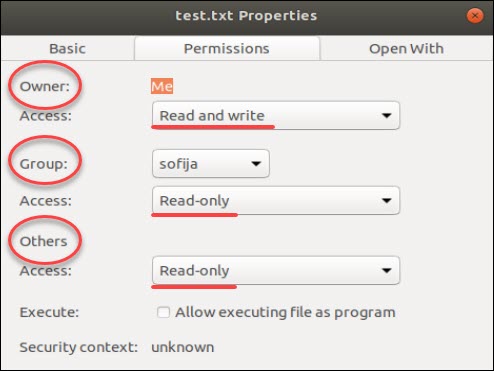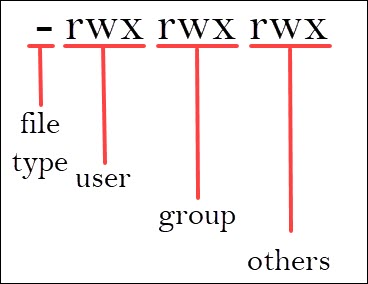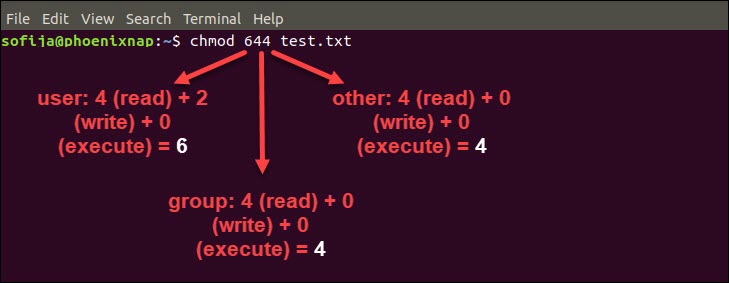- Changing File Permissions Linux
- Linux File Permission Tutorial: How to Check and Change Permissions
- How to View Check Permissions in Linux
- Check Permissions using GUI
- Check Permissions in Command-Line with Ls Command
- Using Chmod Command to Change File Permissions
- Define File Permission with Symbolic Mode
- Define File Permission in Octal/Numeric Mode
- Changing User File and Group Ownership
Changing File Permissions Linux
The chmod command is used to change the permissions of a file or directory. To use it, you specify the desired permission settings and the file or files that you wish to modify. There are two ways to specify the permissions, but I am only going to teach one way.
It is easy to think of the permission settings as a series of bits (which is how the computer thinks about them). Here’s how it works:
rwx rwx rwx = 111 111 111 rw- rw- rw- = 110 110 110 rwx --- --- = 111 000 000 rwx = 111 in binary = 7 rw- = 110 in binary = 6 r-x = 101 in binary = 5 r-- = 100 in binary = 4 (rwxrwxrwx) No restrictions on permissions. Anybody may do anything. Generally not a desirable setting.
(rwxr-xr-x) The file’s owner may read, write, and execute the file. All others may read and execute the file. This setting is common for programs that are used by all users.
(rwx——) The file’s owner may read, write, and execute the file. Nobody else has any rights. This setting is useful for programs that only the owner may use and must be kept private from others.
(rw-rw-rw-) All users may read and write the file.
(rw-r—r—) The owner may read and write a file, while all others may only read the file. A common setting for data files that everybody may read, but only the owner may change.
(rw——-) The owner may read and write a file. All others have no rights. A common setting for data files that the owner wants to keep private.
Directory permissions
The chmod command can also be used to control the access permissions for directories. In most ways, the permissions scheme for directories works the same way as they do with files. However, the execution permission is used in a different way. It provides control for access to file listing and other things. Here are some useful settings for directories:
(rwxrwxrwx) No restrictions on permissions. Anybody may list files, create new files in the directory and delete files in the directory. Generally not a good setting.
(rwxr-xr-x) The directory owner has full access. All others may list the directory, but cannot create files nor delete them. This setting is common for directories that you wish to share with other users.
(rwx——) The directory owner has full access. Nobody else has any rights. This setting is useful for directories that only the owner may use and must be kept private from others.
Use this command on terminal
to grant all access (Read, Write, Execute).
If you don’t need execution access and need only right access then
In general, chmod commands take the form:
chmod options permissions filename If no options are specified, chmod modifies the permissions of the file specified by filename to the permissions specified by permissions.
permissions defines the permissions for the owner of the file (the user ), members of the group who owns the file (the group ), and anyone else ( others ). There are two ways to represent these permissions: with symbols (alphanumeric characters), or with octal numbers (the digits 0 through 7).
Here the digits 7, 5, and 4 each individually represent the permissions for the user, group, and others, in that order. Each digit is a combination of the numbers 4, 2, 1, and 0:
- 4 stands for «read»,
- 2 stands for «write»,
- 1 stands for «execute», and
- 0 stands for «no permission.»
So 7 is the combination of permissions 4+2+1 (read, write, and execute), 5 is 4+0+1 (read, no write, and execute), and 4 is 4+0+0 (read, no write, and no execute).
I think, you got the idea. For more detail read man entry of chmod (this page).
Use chmod command, as a example ;
To change the owner of the file use chown as in
Old post, but maybe somebody will still find useful my answer.
If you want to give access to all users (or «other than owner» — meaning last digit ) you can run next command:
cd sudo find . -perm 750 -exec chmod 757 <> +; It will find all files with permission 750 (read + write + execute for owner user / read + execute for group owner / nothing for other users) and by changing just last digit, you give the same permission as owner, to all other users. (last 7 meaning read + write + execute for other users)
Of course, you can run the command with different digits, but just replace last digit with the value of first on. For example, run next commands to ensure that all file that are read + write + executable for owner , will have the same right access for ‘other’:
sudo find . -perm 700 -exec chmod 707 <> +; sudo find . -perm 701 -exec chmod 707 <> +; sudo find . -perm 702 -exec chmod 707 <> +; sudo find . -perm 703 -exec chmod 707 <> +; sudo find . -perm 704 -exec chmod 707 <> +; sudo find . -perm 705 -exec chmod 707 <> +; sudo find . -perm 706 -exec chmod 707 <> +; If you will continue in this way (having one line for every combination 7xx), you will end up running 77 commands. Which is a bit too much. right?
Luckily, there can be done a trick. You can use «-» in front of the number that meaning that the file has «at least» that number. For example, running:
will return all files that have permission 775, 776 and 777. Another example is running:
that will return files with permision 770, 771 . 777.
In our case, we are care only about first digit and we want to change last digit with its value, so there can used:
sudo find . -perm 700 -exec chmod 777 <> +; **> This will work only for files on which owner has read + write +
execute. If you will try above command with 600 instead of 700, keep in mind that it will return also files with permission 6xx and files with permission 7xx.**
Linux File Permission Tutorial: How to Check and Change Permissions
Linux, like other Unix-like operating systems, allows multiple users to work on the same server simultaneously without disrupting each other.
Individuals sharing access to files pose a risk exposing classified information or even data loss if other users access their files or directories. To address this, Unix added the file permission feature to specify how much power each user has over a given file or directory.
In this tutorial, you will learn how to view and change file permissions in Linux.
How to View Check Permissions in Linux
To start with file permissions, you have to find the current Linux permission settings. There are two options to choose from, depending on your personal preference: checking through the graphical interface or using the command.
Check Permissions using GUI
Finding the file (directory) permission via the graphical user interface is simple.
1. Locate the file you want to examine, right-click on the icon, and select Properties.
2. This opens a new window initially showing Basic information about the file.
Navigate to the second tab in the window, labeled Permissions.
3. There, you’ll see that the permission for each file differs according to three categories:
- Owner (the user who created the file/directory)
- Group (to which the owner belongs to)
- Others (all other users)
For each file, the owner can grant or restrict access to users according to the categories they fall in.
In our example, the owner of the file test.txt has access to “Read and write”, while other members of its group, as well as all other users, have “Read-only” access. Therefore, they can only open the file, but cannot make any modifications.
To alter the file configuration, the user can open the drop-down menu for each category and select the desired permission.
Additionally, you can make the file executable, allowing it to run as a program, by checking the Execute box.
Check Permissions in Command-Line with Ls Command
If you prefer using the command line, you can easily find a file’s permission settings with the ls command, used to list information about files/directories. You can also add the –l option to the command to see the information in the long list format.
To check the permission configuration of a file, use the command:
For instance, the command for the previously mentioned file would be:
As seen in the image above, the output provides the following information:
- file permission
- the owner (creator) of the file
- the group to which that owner belongs to
- the date of creation.
It shows the permission settings, grouped in a string of characters (-, r, w, x) classified into four sections:
- File type. There are three possibilities for the type. It can either be a regular file (–), a directory (d) or a link (i).
- File permission of the user (owner)
- File permission of the owner’s group
- File permission of other users
The characters r, w, and x stand for read, write, and execute.
The categories can have all three privileges, just specific ones, or none at all (represented by –, for denied).
Users that have reading permission can see the content of a file (or files in a directory). However, they cannot modify it (nor add/remove files in a directory). On the other hand, those who have writing privileges can edit (add and remove) files. Finally, being able to execute means the user can run the file. This option is mainly used for running scripts.
In the previous example, the output showed that test.txt is a regular file with read and write permission assigned to the owner, but gives read-only access to the group and others.
Using Chmod Command to Change File Permissions
As all Linux users, you will at some point need to modify the permission settings of a file/directory. The command that executes such tasks is the chmod command.
chmod [permission] [file_name]There are two ways to define permission:
- using symbols (alphanumerical characters)
- using the octal notation method
Define File Permission with Symbolic Mode
To specify permission settings using alphanumerical characters, you’ll need to define accessibility for the user/owner (u), group (g), and others (o).
Type the initial letter for each class, followed by the equal sign (=) and the first letter of the read (r), write (w) and/or execute (x) privileges.
To set a file, so it is public for reading, writing, and executing, the command is:
chmod u=rwx,g=rwx,o=rwx [file_name]To set permission as in the previously mentioned test.txt to be:
• read and write for the user
• read for the members of the group
• read for other users
Use the following command:
Note: There is no space between the categories; we only use commas to separate them.
Another way to specify permission is by using the octal/numeric format. This option is faster, as it requires less typing, although it is not as straightforward as the previous method.
Instead of letters, the octal format represents privileges with numbers:
The privileges are summed up and depicted by one number. Therefore, the possibilities are:
- 7 – for read, write, and execute permission
- 6 – for read and write privileges
- 5 – for read and execute privileges
- 4 – for read privileges
As you have to define permission for each category (user, group, owner), the command will include three (3) numbers (each representing the summation of privileges).
For instance, let’s look at the test.txt file that we symbolically configured with the chmod u=rw,g=r,o=r test.txt command.
The same permission settings can be defined using the octal format with the command:
Define File Permission in Octal/Numeric Mode
Note: If you need a more in-depth guide on how to use Chmod In Linux to change file permissions recursively, read our Chmod Recursive guide.
Changing User File and Group Ownership
Aside from changing file permissions, you may come across a situation that requires changing the user file ownership or even group ownership.
Performing either of these tasks requires you first need to switch to superuser privileges. Use one of the options outlined in the previous passage.
To change the file ownership use the chown command:
chown [user_name] [file_name]Instead of [user_name] type in the name of the user who will be the new owner of the file.
To change the group ownership type in the following command:
chgrp [group_name] [file_name]Instead of [group_name] type in the name of the group that will be the new owner of the file.
Learning how to check and change permissions of Linux files and directories are basic commands all users should master. To change file’s group permissions, you might find helpful our article on how to use the chgrp command.
No matter whether you prefer using the GUI or command-line, this article should help you better understand how to use file permissions.







